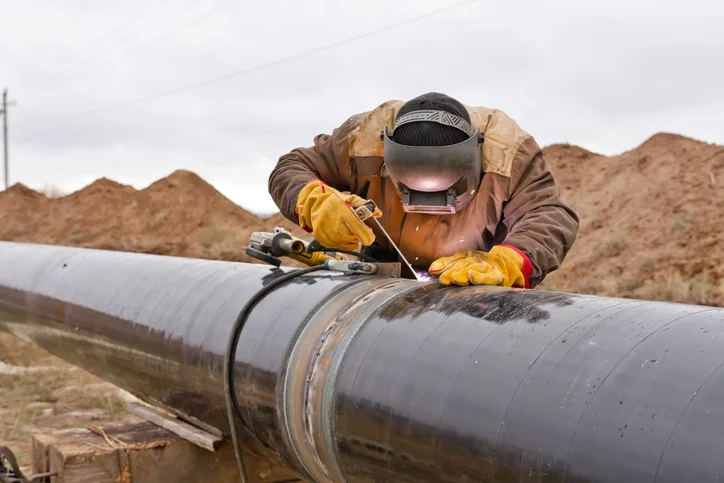Comprehensive Overview of Pipeline Welding Assessment Treatments
In the realm of pipeline building and construction, ensuring the integrity and safety of bonded joints is paramount. Pipe welding evaluation procedures play a critical duty in guaranteeing that welded connections fulfill rigid industry requirements and specs. From precise pre-welding evaluations to detailed post-weld evaluations, a well-defined assessment process is important for preserving the structural soundness of pipes. Recognizing the intricacies of welding examination procedures is not only a regulatory requirement yet also a fundamental element of upholding the reliability of these crucial infrastructures.
Pre-welding Evaluation Preparations
Prior to commencing the welding process, comprehensive pre-welding evaluation prep work are necessary to make sure the integrity and top quality of the weld joint. These prep work entail a precise assessment of the materials to be bonded, the welding equipment, and the workplace. First of all, the materials should be evaluated for any issues, pollutants, or disparities that could endanger the weld. This includes checking for proper material qualities, measurements, and surface conditions. Pipeline Welding Inspection. Additionally, the welding tools requires to be examined to confirm that it remains in good functioning problem, adjusted correctly, and ideal for the certain welding procedure. Any problems with the tools need to be dealt with promptly to stop issues in the weld. The work atmosphere must be assessed for tidiness, appropriate air flow, and safety measures to make certain a favorable setup for the welding operation. By performing complete pre-welding examination preparations, potential problems can be determined and solved at an early stage, leading to trusted and high-grade weld joints.
Welding Treatment Qualification
Thorough pre-welding assessment prep work lay the structure for the vital process of Welding Procedure Certification, ensuring the stability and quality of the weld joint. Welding Treatment Credentials (WPQ) is a crucial action in the welding process that involves testing and certifying welding procedures to guarantee they fulfill specific criteria and requirements. The WPQ procedure commonly includes welding treatment specification growth, welding procedure credentials testing, and documentation of the outcomes.
Throughout welding procedure specification growth, important details such as the welding procedure, welding products, joint style, and welding criteria are specified to develop a comprehensive treatment. Subsequently, welding treatment credentials testing is carried out to validate the recommended procedure's integrity. This testing often involves welding test promo codes that undergo various mechanical and non-destructive examinations to analyze the weld's high quality and adherence to the specified requirements.
In-process Weld Inspection
Throughout the welding process, in-process weld examination plays an important duty in making sure the quality and stability of the weld joint - Pipeline Welding Inspection. This kind of inspection involves checking the welding parameters, examining the weld grain development, and detecting any type of possible defects or gaps as they occur. By carrying out in-process weld inspections, welding drivers can immediately address any kind of problems that might emerge, thereby protecting against further issues and ensuring that the final weld satisfies the required specifications
Typical methods made use find more of for in-process weld inspection include visual inspection, fluid penetrant testing, magnetic bit screening, ultrasonic screening, and radiographic screening. On the whole, in-process weld inspection is vital for keeping the quality and integrity of bonded pipes.
Non-destructive Testing (NDT)
Non-destructive Testing (NDT) is an essential approach used in pipe welding assessment to assess the honesty of weld joints without causing damages to the bonded framework. By making use of numerous NDT techniques, examiners can examine the high quality of welds and determine any type of issues or suspensions that might compromise the structural sturdiness of the pipe. Common NDT methods utilized in pipeline welding examination consist of Radiographic Screening (RT), Ultrasonic Screening (UT), Magnetic Bit Testing (MPT), Liquid Penetrant Screening (LPT), and Visual Screening (VT)
RT involves the usage of X-rays or gamma rays to generate pictures of the interior framework of the weld, allowing assessors to identify issues such as porosity, splits, or insufficient fusion. Additionally, VT includes visual examination of welds to recognize any best site type of visible flaws.
Post-weld Assessment and Documents

Documentation of post-weld examination findings is essential for keeping top quality control documents and making sure conformity with industry criteria and guidelines. Detailed records need to include details about the assessment techniques made use of, the place and nature of look at this website any issues found, and any kind of corrective activities taken - Pipeline Welding Inspection. Correct documentation not just serves as a record of the weld's top quality however additionally aids in future upkeep and inspection procedures
Verdict

Finally, pipeline welding inspection treatments play an essential duty in guaranteeing the high quality and integrity of welds. From pre-welding inspections to post-weld paperwork, each step is essential in keeping the safety and security and performance of pipes. By following recognized treatments and performing complete inspections, potential defects can be identified and resolved prior to they result in pricey fixings or failures. In general, adherence to proper examination procedures is crucial to the success of pipeline welding jobs.
From careful pre-welding examinations to detailed post-weld assessments, a well-defined assessment process is necessary for preserving the structural soundness of pipes. By conducting in-process weld assessments, welding operators can immediately resolve any kind of issues that might occur, therefore making sure and stopping additional problems that the final weld meets the called for requirements.
Common techniques made use of for in-process weld inspection include aesthetic examination, liquid penetrant screening, magnetic bit testing, ultrasonic screening, and radiographic screening.Non-destructive Testing (NDT) is an essential technique utilized in pipeline welding examination to examine the stability of weld joints without creating damages to the bonded framework. Post-weld inspection entails different methods to evaluate the welds for issues, consisting of aesthetic assessment, color penetrant testing, magnetic fragment testing, ultrasonic screening, and radiographic screening.